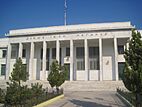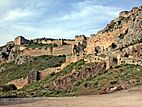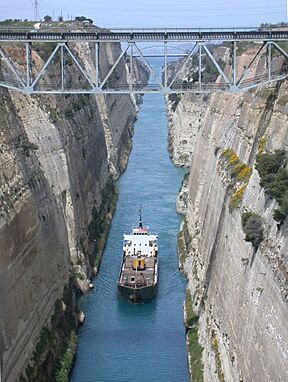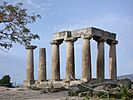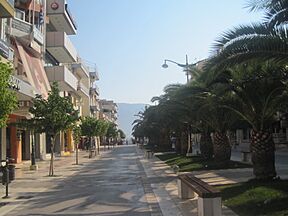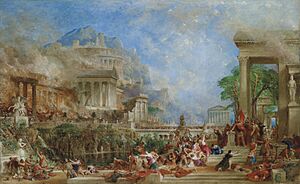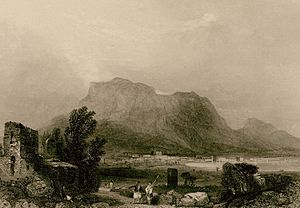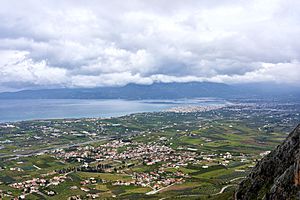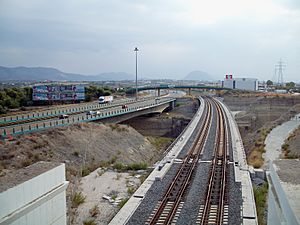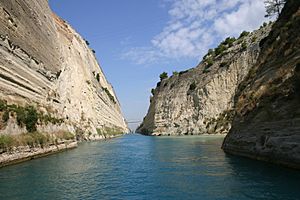Corinth facts for kids
Quick facts for kids
Corinth
Κόρινθος
|
||
|---|---|---|
|
Clockwise from top left: Corinth Courthouse, the walled gates of Acrocorinth, Isthmus of Corinth, Statue of Pegasus, Ethnikis Antistaseos, Temple of Apollo
|
||
|
||
| Country | Greece | |
| Administrative region | Peloponnese | |
| Regional unit | Corinthia | |
| Municipality | Corinth | |
| • Municipal unit | 102.19 km2 (39.46 sq mi) | |
| Highest elevation | 10 m (30 ft) | |
| Lowest elevation | 0 m (0 ft) | |
| Population
(2021)
|
||
| • Municipal unit | 38,485 | |
| • Municipal unit density | 376.602/km2 (975.40/sq mi) | |
| Demonym(s) | Corinthian | |
| Community | ||
| • Population | 30,816 (2021) | |
| Time zone | UTC+2 (EET) | |
| • Summer (DST) | UTC+3 (EEST) | |
| Postal code |
20100
|
|
| Area code(s) | (+30) 27410 | |
| Vehicle registration | KP | |
Corinth (pronounced KORR-inth) is a city in Corinthia, Greece. It's a modern city built near the famous ancient city of Corinth. Today, it's the capital of the Corinthia region.
The city we see now was founded in 1858. It was named New Corinth (Nea Korinthos) because an earthquake had destroyed the older settlement. That older town had grown up around the ancient city's ruins.
Contents
History of Corinth
Corinth gets its name from the very old city-state of Ancient Corinth. People lived in this area for a very long time, even before 3000 BC.
Ancient Greek Times
Around the 8th century BC, ancient Corinth started to become an important place for trade. A powerful family called the Bacchiads ruled Corinth for a while. Later, a leader named Cypselus took control. He and his son Periander ruled Corinth as "Tyrants" from 657 to 550 BC. A tyrant in ancient Greece was a ruler who took power, not always a bad person.
Around 550 BC, a group of wealthy families took over the government. This new government became friends with Sparta. They joined the Peloponnesian League, a group of Greek city-states. Corinth fought alongside Sparta in the Persian Wars and the Peloponnesian War. After Sparta won the Peloponnesian War, Corinth decided to follow its own path in later wars.
Later, when Macedonia united Greece, the Acrocorinth (a big rock with a fortress) became a Macedonian military base. But in 243 BC, Corinth joined the Achaean League, a group of independent Greek cities.
Roman Times
About 100 years later, in 146 BC, the Roman army captured Corinth and completely destroyed it.
However, Corinth was rebuilt as a Roman colony in 44 BC. It grew strong again and became the main city of the Roman province called Achaea.
Modern Era
In 1858, the old city of Corinth, now called Ancient Corinth, was completely destroyed by a strong earthquake. It was about 3 kilometers (2 miles) southwest of where the modern city is today. So, New Corinth was built closer to the coast of the Gulf of Corinth.
The new city also faced challenges. In 1928, another earthquake hit, and the city had to be rebuilt again. Then, in 1933, a big fire caused more damage, leading to yet another rebuilding effort. During World War II, the city was used as a camp for prisoners of war.
Geography
Corinth is about 78 kilometers (48 miles) west of Athens. It's surrounded by smaller towns like Lechaio and Isthmia.
The city is located near some interesting natural features. These include the narrow coastal plain of Vocha and the Gulf of Corinth. The famous Isthmus of Corinth is also nearby, which is a narrow strip of land cut by the Corinth Canal. Other features include the Saronic Gulf, the Oneia Mountains, and the huge rock of Acrocorinth, where a medieval fortress once stood.
Climate
Corinth has a Mediterranean climate. This means it has hot, dry summers and cool, rainy winters. The hottest month is July, with an average temperature of 28.7°C (83.7°F). The coldest month is January, with an average temperature of 9.1°C (48.4°F). Corinth gets about 463 millimeters (18.2 inches) of rain each year.
| Climate data for Velo, Corinth (1988–2010) | |||||||||||||
|---|---|---|---|---|---|---|---|---|---|---|---|---|---|
| Month | Jan | Feb | Mar | Apr | May | Jun | Jul | Aug | Sep | Oct | Nov | Dec | Year |
| Mean daily maximum °C (°F) | 13.4 (56.1) |
13.9 (57.0) |
16.5 (61.7) |
20.3 (68.5) |
25.7 (78.3) |
30.7 (87.3) |
33.2 (91.8) |
32.9 (91.2) |
28.4 (83.1) |
23.6 (74.5) |
18.5 (65.3) |
14.4 (57.9) |
22.6 (72.7) |
| Daily mean °C (°F) | 9.1 (48.4) |
9.4 (48.9) |
11.9 (53.4) |
15.7 (60.3) |
21.1 (70.0) |
26.1 (79.0) |
28.7 (83.7) |
28.1 (82.6) |
23.4 (74.1) |
18.8 (65.8) |
13.8 (56.8) |
10.5 (50.9) |
18.1 (64.5) |
| Mean daily minimum °C (°F) | 5.3 (41.5) |
5.0 (41.0) |
6.5 (43.7) |
9.0 (48.2) |
12.9 (55.2) |
16.8 (62.2) |
19.5 (67.1) |
19.8 (67.6) |
16.9 (62.4) |
13.8 (56.8) |
9.9 (49.8) |
6.9 (44.4) |
11.9 (53.3) |
| Average precipitation mm (inches) | 72.0 (2.83) |
50.9 (2.00) |
53.7 (2.11) |
28.7 (1.13) |
22.3 (0.88) |
6.4 (0.25) |
5.0 (0.20) |
11.9 (0.47) |
19.4 (0.76) |
40.8 (1.61) |
73.5 (2.89) |
78.6 (3.09) |
463.2 (18.22) |
| Source: HNMS | |||||||||||||
Demographics
| Historical population | ||
|---|---|---|
| Year | Pop. | ±% |
| 2001 | 36,991 | — |
| 2011 | 38,132 | +3.1% |
| 2021 | 38,485 | +0.9% |
In 2021, the Municipality of Corinth had a population of 55,941 people. This makes it the second-largest municipality in the Peloponnese Region, after Kalamata. The city of Corinth itself had 30,816 residents.
The municipal unit of Corinth includes the main city, plus smaller towns like Archaia Korinthos (Ancient Corinth) and Examilia. This whole area covers about 102 square kilometers (39 square miles).
Economy
Industry
Corinth is an important industrial center in Greece. The Corinth Refinery is one of the biggest oil refineries in Europe. Many different products are made here, such as ceramic tiles, copper cables, and medical equipment. They also produce mineral water, meat products, and salt.
Transport
Roads
Corinth is a major crossroads for roads. The A7 highway goes to Tripoli and Kalamata. This road branches off the A8 highway from Athens. Corinth is like a gateway to the Peloponnesian peninsula, which is the southernmost part of mainland Greece.
Bus
KTEL Korinthias provides bus services. You can take buses from Corinth to other towns in the peninsula and to Athens. There are also local bus services within the city.
Railways
A railway line from Athens reached Corinth in 1884. This old station closed in 2007. However, in 2005, a new Corinth railway station opened. Now, you can travel from Athens to Corinth by train in about 55 minutes. The train station is a short drive from the city center.
Port
The port of Corinth is north of the city center, near the entrance of the Corinth Canal. It helps local industries and farms. It's mainly used for exporting goods like citrus fruits, grapes, and marble. The port has a customs office and a Coast Guard post.
Canal
The Corinth Canal is a famous waterway. It connects the western Mediterranean Sea to the Aegean Sea. It's about 4 kilometers (2.5 miles) east of the city. The canal cuts through the Isthmus of Corinth, which is a narrow strip of land. This effectively makes the Peloponnesian peninsula an island.
The canal is dug at sea level, so it doesn't have any locks. It is 6.4 kilometers (4 miles) long but only 21.3 meters (70 feet) wide at its base. This narrowness means that most modern ships cannot pass through it. Because of this, it's not very important for trade anymore.
People thought about building this canal even in ancient times. Julius Caesar and Caligula considered it, but they died before starting. The Roman emperor Nero was the first to actually try building it. His workers included 6,000 Jewish prisoners of war.
Modern construction began in 1882, after Greece became independent. But there were many problems with the ground and money, which caused the original builders to go bankrupt. The canal was finally finished in 1893. However, because it was so narrow and there were often landslides from its steep walls, it didn't get as much ship traffic as expected. Today, it is mainly used by tourist boats.
Sport
Corinth has a football (soccer) team called Korinthos F.C.. It was formed in 1999 when two other local teams joined together. The team has played in different Greek football leagues.
Twin towns/sister cities
Corinth is connected with other cities around the world as "twin towns" or "sister cities." These connections help promote friendship and understanding.
Notable people
- Anastasios Bakasetas (1993–), Greek footballer
- Evangelos Ikonomou (1987–), Greek footballer
- George Kollias (1977–), drummer for the band Nile.
- Irene Papas (1929–2022), Greek actress
- Panagis Tsaldaris (1868–1936), Greek politician and former prime minister of Greece
Other locations named after Corinth
Because of its long history and the visits of St. Paul the Apostle, some places around the world have been named Corinth.
Images for kids
-
Aerial photograph of the Isthmus of Corinth
See also
 In Spanish: Corinto para niños
In Spanish: Corinto para niños


